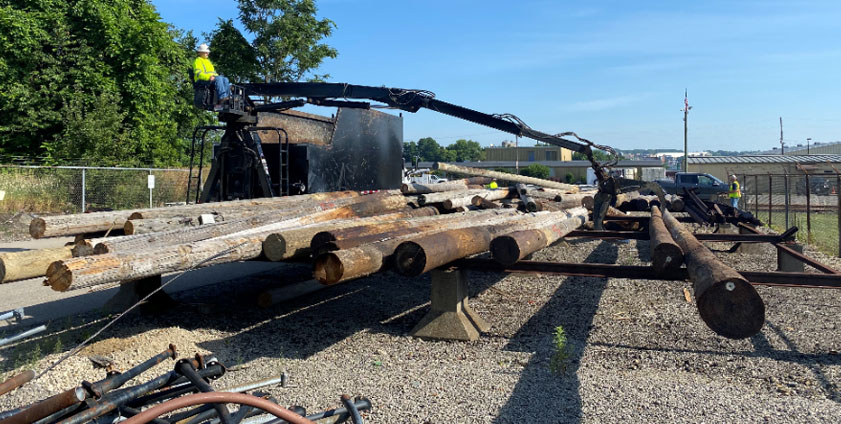One Million Pounds … and Counting

A Blackwood Solutions employee uses a grapple truck to collect discarded utility poles at Ohio Edison's Youngstown Service Building.
October 11, 2021
Utility poles are the backbone of the electrical system, supporting the wires, transformers and other equipment necessary to deliver electricity safely and effectively to customers. They perform their duties year round – during the heat of summer and the cold days of winter – and are typically only replaced when conditions require.
Historically, discarded utility poles have been cut into smaller segments and stored at company service centers until a waste management contractor can transport the pieces to a landfill for proper disposal. However, thanks to a new sustainability program launched by FirstEnergy’s Environmental Department in July 2020, these poles are receiving a new lease on life – getting a second chance to fulfill their purpose of providing support and safety.
“We conducted a one-year trial of the Wood Pole Diversion Program at several Ohio Edison service centers to review the concept and to work out the logistics of the program,” said Che Brindle, advanced scientist. “Since the trial phase of the initiative started, we have diverted more than one million pounds of discarded utility poles from landfills.”
Che’s group met with representatives at our other operating companies before deciding to roll out the program across FirstEnergy’s five-state territory in July. “We already are seeing requests for pole collection in the other states we serve outside of Ohio, which is very rewarding for everyone involved in the launch of this initiative,” he said.
How the Program Works
When a utility pole is damaged and no longer fit for use, FirstEnergy Utilities (FEU) employees remove all hardware and store the pole at one of the participating service centers. After collecting a full load of about 30 to 35 poles, the company works with Blackwood Solutions – a transportation and materials management firm – to pick up and distribute the poles for reuse.
To qualify for the program, poles must measure at least eight feet in length. They are delivered at no cost to interested parties who meet the following criteria: willing to accept a full load, located within a certain distance from the collection sites, and have property that can be accessed by a tractor trailer.
According to Che, interested parties often can include farmers, mills, charitable organizations, and even company employees. “Discarded utility poles have many alternative uses,” he explained. “They can be turned into fencing, parking bollards and guide rails, or used for landscaping and treated wood construction. Some talented people even make furniture out of the poles, creating benches, tables and stools.”

(L.) Retaining walls are among the various uses for discarded utility poles. (R.) Parking bollards constructed of utility poles.
Harvesting Utility Poles in West Virginia
West Virginia Operations President Jim Myers is excited about the benefits the initiative will bring to Mon Power. “The Wood Pole Diversion Program is an opportunity for us to adopt a more environmentally friendly practice and find new uses for an item that previously was discarded in landfills,” he said. “This is a great example of our commitment to reducing waste and improving our sustainability efforts in all aspects of our business.”
| Did You Know?
A parking bollard is a short post – made out of cement, wood or other materials – that can be used to guide traffic, mark boundaries, and physically block vehicles to protect people and property. You may notice them at gas stations, in parking lots, along walking trails, and in front of buildings. |
While it could take up to a year for Mon Power to accumulate a full load of poles to be recycled, the program is expected to reduce the company’s waste stream significantly over time, as each pole is roughly 50 pounds per cubic foot (most poles weight between 300 and 4,100 pounds). Mon Power currently plans to store used utility poles at 14 of its service centers.
Another benefit of the program is improved housekeeping and safety procedures at company facilities. For example, the poles now will be kept intact for reuse, eliminating the need for workers to cut them into pieces with chainsaws.
Che added that personnel from various departments helped with the testing and roll out of the initiative. “We couldn’t have gotten the program off the ground without assistance from employees in Environmental, Supply Chain, Warehousing & Logistics, Facilities, Corporate Responsibility, and Ohio Edison and our other operating companies,” he said. “Our team is proud to be part of this important sustainability initiative.”
To find out more about participating in the Wood Pole Diversion Program or to contact Blackwood Solutions, please visit www.bwoodsolutions.com. If placing an order for poles, remember to mention that you are a FirstEnergy employee.